International Seminar on Regional Airports
![]() 29th September 2009
29th September 2009
New Forest, UK
Overview
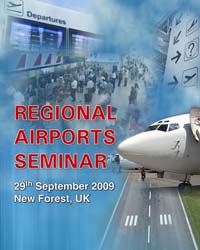
An important seminar was held at Ashurst Lodge in the New Forest Campus of the Wessex Institute of Technology (WIT), on Regional Airports, chaired by Professor Nadia Postorino of the University of Reggio Calabria in Italy and Professor Carlos A. Brebbia, Director of WIT.
Regional Airports have become increasingly important elements of the air network system, both as feeders of hub-and-spoke services and as origins or destination of point-to-point services.
Congestion at the main hubs and increasing demand for air transportation - both for passengers and freight services – necessitates revaluation of the overall air systems, with regional airports taking an ever expanding role. Optimisation of air transportation systems within the framework of other forms of transport plays an important part in the present quest for sustainability. Congestion nowadays is not only associated with countries such as the USA and those in the EU, but also a variety of other countries with fast developing economies where there is a strong increase in air transportation demand.
The revolution of the existing airport system, including regional airports requires the developing of new optimisation tools which can simulate the whole process and produce optimal solutions. These models are also essential to predict future demands and, in particular the role that regional airports will play.
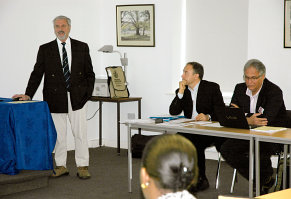 The siting of new airports involves taking into consideration a variety of environmental, ecological, social and economic factors which transcend the problem of transportation resources optimisation itself. Regional Airports can be a powerful driving force behind the development of an area and conversely can result in major problems if they are wrongly sited.
The siting of new airports involves taking into consideration a variety of environmental, ecological, social and economic factors which transcend the problem of transportation resources optimisation itself. Regional Airports can be a powerful driving force behind the development of an area and conversely can result in major problems if they are wrongly sited.
Carlos opened the proceedings by explaining the importance of this type of international seminar for the activities of WIT, whose aim is to be a centre for the transfer of knowledge across all disciplines. He presented some of the projects being studied at WIT, to emphasize the interdisciplinary character of most of the work at the lodge. WIT’s unique expertise in computer models continues to be applied for the solution of a wide variety of problems.
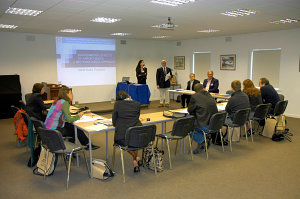 Carlos explained the importance of being able to communicate with different specialists and society as a whole for finding solutions to the very serious challenges facing the world today.
Carlos explained the importance of being able to communicate with different specialists and society as a whole for finding solutions to the very serious challenges facing the world today.
WIT is particularly involved in environmental and ecological projects, an area in which it collaborates with many institutions around the world. More recently a joint initiative with the University of Siena in Italy has resulted in the launching of the Prigogine Gold Medal to honour the memory of the Nobel Prize winner, whose impact on what he called the “soft” science (such as economics, politics, social sciences etc.) was equal to his major contribution to the “hard” science, particularly chemistry, an area of research which led to him being awarded the Nobel Prize.
The Prigogine Medal has been awarded since 2004 to an outstanding group of scientists, all of them his disciples who were significantly influenced by Prigogine’s work. They are:
- Professor Sven Jørgensen (2004) University of Pharmaceutical Sciences, Denmark
- Professor Enzo Tiezzi (2005) University of Siena, Italy
- Professor Bernard Patten (2006) University of Georgia, USA
- Professor Robert Ulanowicz (2007) University of Maryland, USA
- Professor Ioannis Antoniou (2008) Aristotle University of Thessalonica, Greece
- Professor Emilio Del Giudice (2009) University of Naples, Italy
Seminar Presentations
The Regional Airports seminar included some interesting presentations by delegates from different countries.
- “Environmental effects of airport nodes: A methodological approach” by M N Postorino, University of Reggio Calabria, Italy
- “Regional airports and the accessibility of mountain areas: networks, importance and contribution to development” by X Bernier, University of Savoie, France
- “Analysis of the regional air passenger transport system in Brazil: Some aspects of its evolution and diagnosis” by S C Ribeiro, COPPE Federal University of Rio de Janeiro, Brazil
- “Runway friction management” by Girish Reesaul, Gatwick Airport Ltd. UK
- “Airport airline relationships. Opportunities for Italian Regional Airports” by S Cepolina, University of Geneva, Italy
- “Exploring multi criteria decision analysis method as a tool to choose regional airport hubs within Africa” by B Ssamula, CSIR, South Africa
- “Perspectives from social and cultural geography” by P Adey, Keele University, UK
- “Potential demand for new high speed rail services in high dense air transport corridors” by C Roman, University of Las Palmas de Gran Canaria, Spain
- “Regional airport: Study on economic and social profitability” by S Amoroso, University of Palermo, Italy
- “The sustainable logistics platform in the Brazilian reality” by F Lima, UNICAMP, Brazil
- “Regional airports environmental management: key messages from ten European airports evaluation” by A J Voskaki, Cranfield University, UK
Museum Visit
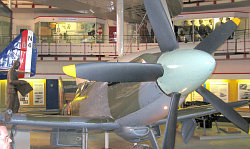 The seminar gave the participants ample opportunity for having formal and informal discussion. A series of social activities were planned, including a guided visit to Southampton Aviation Museum, where the participants were shown around by the Head Archivist and a member of staff that showed them the Flying Boat cockpit. Southampton is famous as the birthplace of the Spitfire fighter production, which was afterwards moved to Coventry, a city that was heavily bombed. The expertise available at the time was the foundation of the Aeronautics Engineering Department at Southampton University.
The seminar gave the participants ample opportunity for having formal and informal discussion. A series of social activities were planned, including a guided visit to Southampton Aviation Museum, where the participants were shown around by the Head Archivist and a member of staff that showed them the Flying Boat cockpit. Southampton is famous as the birthplace of the Spitfire fighter production, which was afterwards moved to Coventry, a city that was heavily bombed. The expertise available at the time was the foundation of the Aeronautics Engineering Department at Southampton University.
Seminar Dinner
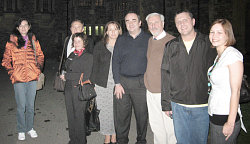 A conference banquet took place at the end of the seminar in one of the most interesting houses of the New Forest, now a luxury hotel. This is Rhinefield House, which was built as a private residence resembling an old castle. The house has unique gardens, which include a series of ponds and fountains, a maze, an open air auditorium and many other attractive features. The trees leading up to the house are also exceptional for their variety and rarity, a result of the site having been the nursery for the whole of the Forest. The most interesting sights are however a series of rooms inside the house, each of these decorated in a different style. The Great Hall at the entrance deserves special mention for the quality of the wood panelling, and its unique hammer-beam type roof, similar to that of the old Westminster Hall in the Houses of Parliament. Other rooms are decorated in French and Italianate styles, and a further one has a remarkable woodcarving in the mantelpiece representing the defeat of the Spanish Armada. The most stunning room is a small one decorated with the type of gesso work typical of the Spanish Arabic architecture such as the Alhambra Palace in Granada. Here, the delegates had an excellent dinner accompanied by good wines. It was a fitting way to conclude a most successful seminar.
A conference banquet took place at the end of the seminar in one of the most interesting houses of the New Forest, now a luxury hotel. This is Rhinefield House, which was built as a private residence resembling an old castle. The house has unique gardens, which include a series of ponds and fountains, a maze, an open air auditorium and many other attractive features. The trees leading up to the house are also exceptional for their variety and rarity, a result of the site having been the nursery for the whole of the Forest. The most interesting sights are however a series of rooms inside the house, each of these decorated in a different style. The Great Hall at the entrance deserves special mention for the quality of the wood panelling, and its unique hammer-beam type roof, similar to that of the old Westminster Hall in the Houses of Parliament. Other rooms are decorated in French and Italianate styles, and a further one has a remarkable woodcarving in the mantelpiece representing the defeat of the Spanish Armada. The most stunning room is a small one decorated with the type of gesso work typical of the Spanish Arabic architecture such as the Alhambra Palace in Granada. Here, the delegates had an excellent dinner accompanied by good wines. It was a fitting way to conclude a most successful seminar.
Publication of Papers
The contributors of the seminar are now processed for publication in a special issue of the International Journal of Sustainable Development and Planning with Professor Nadia Posterino as Guest Editor. Copies of this issue will be available from WIT Press:
International Journal of Sustainable Development and Planning (Print ISSN: 1743-7601; Online ISSN: 1743-741X) is available from WIT Press. Orders can be placed by telephone: +44 (0) 238 029 3223, fax: +44 (0) 238 029 2853, e-mail: This email address is being protected from spambots. You need JavaScript enabled to view it. or via the WIT Press Journals web site at http://library.witpress.com
Development of Airports: Theoretical Analyses and Case Studies, by M.N. Postorino (Forthcoming Publication), approx. 185pp (ISBN 1-84564-143-6) is available in hard back from WIT Press, priced at £69.00. Orders can be placed as above.

 Wessex Institute
Wessex Institute